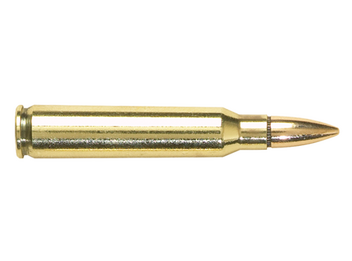
5.56 XM193 ball round.
The 5.56×45mm NATO (official NATO nomenclature 5.56 NATO) is a high velocity, small caliber intermediate rifle cartridge developed in the United States and originally chambered in the M16 rifle, however it is also a a general-purpose round used in many light machine guns as well. Under STANAG 4172, it is a standard cartridge for NATO forces as well as many non-NATO countries. It is derived from, but not identical to, the .223 Remington varmint cartridge. 5.56 is cheap and light, allowing for soldiers to carry more ammunition on them for their rifles. The small projectile focuses on velocity to increase accuracy and tumbling upon hitting the target, thus making the likelihood of hitting a vital organ or vein better. However, 5.56 has received heated criticism for its allegedly poor performance on the battlefield, largely from soldiers. Criticism began in the Vietnam War when soldiers had to fight against the more powerful 7.62 AK-47.
Several 5.56 weapons are seen in the Rambo film series.
Design and Characteristics[]
In the 1950s, the 7.62×51mm NATO rifle cartridge (sold commercially as the .308 Winchester rifle cartridge) was selected to replace the .30-06 Springfield as the standard NATO rifle cartridge. At the time of selection, there had been criticism that the 7.62×51mm NATO was too powerful for light weight modern service rifles, causing excessive recoil, and that the ammunition did not allow for sufficient rate of fire in modern combat. As a result, the US military decided to go with an intermediate round for their rifles, similar to what the Soviets had done with their standard service rounds, 7.62x39 and 5.45x39. During the late 1950s, ArmaLite and other U.S. firearm designers started their individual Small Caliber/High Velocity (SCHV) assault rifle experiments using the commercial .222 Remington cartridge, originally designed for coyote hunting. When it became clear that there was not enough powder capacity to meet U.S. Continental Army Command's (CONARC) velocity and penetration requirements, ArmaLite contacted Remington to create a similar cartridge with a longer case body and shorter neck. This became the .222 Remington Special. At the same time, Springfield Armory's Earle Harvey had Remington create an even longer cartridge case then known as the .224 Springfield. Springfield was forced to drop out of the CONARC competition, and thus the .224 Springfield was later released as a commercial sporting cartridge known as the .222 Remington Magnum. To prevent confusion with all of the competing .222 cartridge designations, the .222 Remington Special was renamed the .223 Remington. With the U.S. military adoption of the ArmaLite M16 rifle in 1963, the .223 Remington was standardized as the 5.56×45mm NATO, with only a few minor differences, one of the main ones being that 5.56 is generally loaded to higher pressures than .223 Remington. 5.56 has been adopted for a few reasons, one of the main ones being NATO's requirement for a certain number of maims and a certain number of kills. 5.56 is good for piercing soft armor and lodging in bone to injure the target, thus taking the person out of combat without killing that person. Another reason for its adoption is that an 8-man team equipped with the M16 would have the same fire-power as a current 11-man team armed with the M14. U.S. troops were able to carry more than twice as much 5.56×45mm NATO ammunition as 7.62×51mm NATO for the same weight, which would allow them a better advantage against a typical NVA unit armed with AK-47s, however, at the sacrifice of firepower.
